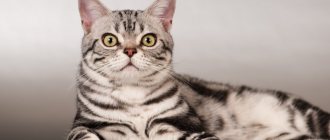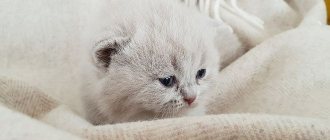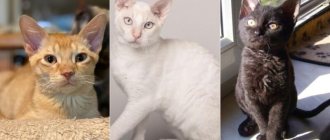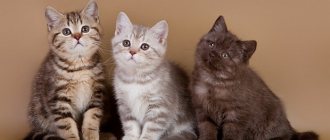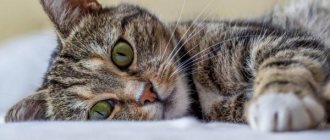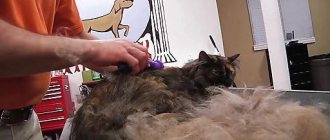The popularity of the Persian cat breed among animal lovers has not decreased over the years. The number of Persian cats registered in various organizations is several times higher than the number of officially registered pets of other breeds. There are quite a few reasons for the popularity of Persians - this breed of cat with big eyes and a luxurious appearance has a reserved disposition and brings joy to the owner with its affectionate behavior. But, despite all the advantages, keeping a Persian at home is troublesome - its thick, long hair requires careful care and regular combing.
For busy people who cannot find time for grooming, breeders recommend paying attention to exotics. This short-haired exotic cat largely repeats the Persian breed standard, but is characterized by one significant difference - thick plush hair, the length of which does not exceed a couple of centimeters. Grooming is simple, so cats will not cause their owners much trouble. Read the article “Mini cat - dwarf breeds with an unusual body structure.”
British Shorthair
This cat breed is quite popular now. It was bred in England in the 19th century by crossing Persian and English domestic. When “plush” British cats began to be shown at exhibitions, they were recognized as the best. The aristocratic public indulged these cats with their attention. And later the breed began to be in demand in other countries.
Today, cats with “plush” fur of the British Shorthair breed are so common that they can be found in almost every home.
Cost of kittens
Among lovers of decorative “sofa” pets, the exotic shorthair cat is extremely popular, which can be bought in a professional nursery. To be convinced of this, just look at the number of likes that Snoopy the cat collects. Nowadays, every animal lover can get a pet with the same doll-like appearance as Snoopy, because you can find good, responsible breeders in almost any region.
The cost of kittens is quite high and depends on their quality. The exhibition breed of exotic cats, whose price is 1200-1300 dollars, is the most expensive. Breed class cats, suitable for participation in breeding work, are more affordable. Their cost is about 600-700 dollars. In the lowest price range, you can purchase a “pet” class pet, such as Snoopy the cat; the price of a kitten of this quality is about $300-500.
If an animal lover likes an exotic shorthair cat, the price of the pet can be discussed with the breeder individually. It is also worth considering the fact that cats in different countries may have different prices. The large discrepancy in price is explained by the fact that in some countries the breed appeared relatively recently and is now at the peak of popularity. Residents of these countries find it difficult to find nurseries that sell exotic cats; you can buy a pet only by pre-order. Therefore, the cost of a cat is very high.
If the breed was brought into the country a long time ago, then the demand for it has already been satisfied and breeders allow themselves to reduce the declared cost of cats to a level acceptable for a wide range of consumers.
Description and character of the breed
The standards of this feline species include the following characteristics:
- the head is large, round in shape, the skull is flat, with wide cheekbones and drooping cheeks;
- the neck is short, with a fold of skin around it;
- the nose is of medium length, wide, forms a depression at the junction of the forehead;
- strong chin;
- medium-sized ears, rounded tips, low set;
- the eyes are large and round, set wide apart, and have a rich color - bright orange, blue or green;
- medium-sized or large, massive body;
- the back is flat, smooth, the chest is wide, weight is from 4 to 6 kg;
- paws are dense, muscular, short;
- the tail is short, thickened at the base and tapering towards the tip;
- The coat is thick, dense, short, reminiscent of plush, of the same length, there is an undercoat, the color can be different.
The character of the British cat is complex. She is balanced, not too active, prefers a measured life. With age she becomes even more sedate. The British are not very attached to the owner, but they avoid strangers. It is important for them to have their own space; they may hide in a secluded corner to be alone. Grooming your cat will not take much time; just brush its fur weekly.
History of the breed
The British Shorthair cat became known back in 1898, but was finally approved as a breed only 84 years later.
Such a long recognition was due to the fact that there were many complaints about the cat’s standards.
To perfect it, breeders worked a lot, crossing the best and most beautiful English domestic cats with Persians (then, after the war, with Russian Blues and Carthusian cats).
The first cat (progenitor of the British breed) is considered to be Harrison Fair.
The story of the appearance of these cats in Britain has two versions. Some claim that they were brought by legionnaires from Rome.
Others insist that the British were brought by French sailors who kept cats as excellent rat catchers.
The favorite pastime for a British cat is chasing a mouse, artificial or real, it doesn’t matter to him
Exotic breed
These cats are loved by many for their appearance, friendly nature and activity. Externally, exotics look like charming toys: large eyes with a surprised expression, a flattened nose and “plush” fur.
The first representatives of the breed appeared in the 50s of the 20th century as a result of an unsuccessful experiment by crossing a Persian with an American shorthair. The breeders' goal was to change the color and make the bones heavier. As a result, the result was not at all what was expected, but the new species pleased the breeders a lot, and it was decided to continue breeding similar cats.
This is how a breed of exotic shorthair appeared, which, by its standards, repeated the parameters of the Persian cat, but was distinguished by unusual hair.
English Manx breed
When looking at this unique cat, the first thing that catches your eye is the absence of a tail. Instead, there is a small depression at the base of the spine, where the tail originates. Manxes are not only tailless; a tail from short to regular length is acceptable.
The history of the breed begins several centuries ago. Some scientists believe that the progenitor of the breed is the British, others consider its appearance to be the merit of the shorthair from the Isle of Man.
The coat is wonderfully soft and plush to the touch, with a dense double texture and a short, dense undercoat. Colors can be very diverse, with the exception of Burmese and Siamese colors.
English Manx cats are very loving animals, with extraordinary loyalty and good hunting instincts. They don't like to swim, but looking at the water in the bathtub or toilet is their favorite pastime. They are distinguished by their special fearlessness.
Description of “plush” cats of an exotic breed
The appearance of representatives of this breed is simply unique, and it is simply impossible to confuse them with any others. The animals are distinguished by their strong build and rounded body shape. Exotics' eyes are round and large, set wide apart. The coat is thick and “plush”.
Description of appearance:
- the skull is large, wide, the head is massive, the neck is short, strong, the nose is short, neat, the cheeks are full, the chin and jaws are strong;
- ears are small, set wide apart, with rounded tips;
- the eyes are large, round and expressive; it is for the expression of the eyes that the breed parameter is noted as “sweet expression of the muzzle”;
- the body is stocky, muscular, the chest is wide;
- the paws are short, strong, with tufts of hair between the toes;
- the tail is short, fluffy, the tip is rounded.
The fur of exotic cats is like plush. Its length is average, the color can be any except light beige and cinnamon.
By nature, exotics are friendly and get along with any family members. However, they need time to get used to new people or animals. Once in a family, the cat will first observe the behavior of its owners. Having looked closely, he will choose the main person to whom he will be devoted, like a dog, and will be simply friendly with everyone else.
Health of exotic pets
Like any purebred cat that appears as a result of crossing representatives of different breeds, exotics can have health problems that are genetic in nature. In addition, exotics are not protected from potential health problems that plague other domestic cats throughout their lives. It is worth noting that the special shape of the nose and muzzle, which gives the cat a gentle doll-like expression, makes exotic cats vulnerable to a number of potential health problems.
Among them are the following ailments:
- facial structure defects;
- breathing problems;
- malocclusion;
- lacrimation.
Among other genetic pathologies in cats, diseases such as:
- entropion;
- polycystic kidney disease;
- hypersensitivity to temperature changes;
- violation of thermoregulation;
- dermatological problems (oily seborrhea, itching, skin irritation, hair loss).
Professional veterinarians also note that exotic cats have a genetic predisposition to fungal infections, so owners should exercise special care and responsibility when keeping cats of this breed. To keep your cat healthy, she needs vaccinations. Read more about cat vaccination in the article “What vaccinations are given to cats and when are the procedures necessary?”
Scottish fold, or Scottish fold
“Teddy” cats of the Scottish Fold breed are incredibly popular due to their appearance. This cat resembles a baby owl - its round face has almost no ears visible, and its eyes are large and round.
The breed originated in Scotland. In 1961, William Ross bought a cat and named her Susie. It was from her that the breed originated after several crossings. The first representatives of the Scots were not very attractive, but after crossing with the British Smoothhair, the cat acquired unique features, and the breed was recognized as independent.
However, the further path to recognition turned out to be very difficult. In 1971, thanks to research, they learned that the gene responsible for the shape of the ears often leads to deafness in animals. Geneticists prohibited the breed. But photos of “plush” cats have already spread around the world and won the hearts of cat lovers. Therefore, they began to look for ways to eliminate the problem, and in the end a solution was found: mating of two Scottish folds was prohibited, they were crossed with straights.
Breed standards:
- the body is medium in size, stocky, with dense bones and a voluminous chest, a wide back, the cat’s weight is 4-7 kg;
- the neck is short, massive, the tail is of medium length, tapering to the tip;
- the head is round;
- the paws are not long, muscular, thick, very similar to the legs of plush toys;
- eyes are large, round, yellow or green;
- short nose;
- the ears are small, with bends covering the shell, with a wide fit, turning forward;
- The fur is short and dense, reminiscent of plush, its color can be different.
Scottish fold character
By nature, cats of this breed are docile and calm. They cannot be called mischievous and active; they are rather intellectuals who do not allow themselves to hang on the curtains or rush around the apartment. It is more pleasant for them to lounge on the sofa near the owner, but there is no need for excessive affection.
The Scottish Fold likes people who respect their personal space. Although outwardly the cat looks indifferent, in fact it is loyal, it just does not show its feelings. This is almost the calmest cat breed in the whole world. Scottish Folds do not show aggression, do not get into conflicts, and rarely meow. These cats love to take interesting poses - stretching out their paws, standing in a column like meerkats, sleeping on their backs.
One of the characteristics of the breed is the inability to jump from heights, so Scottish Folds try to stay in the lower part of the room.
“Teddy” cats of the Scottish Fold breed are very friendly and become attached to members of the human family where they live. They are ideal four-legged friends for children, you can play with them, but you shouldn’t offend them, these cats have a vulnerable psyche.
Scottish Folds have a developed intelligence, they are excellent at learning commands and tricks, but they strive to do only what interests them. Their reluctance to follow anyone's lead is often interpreted as laziness.
Caring for a cat of this breed involves brushing the fur once a week, but you should not do this with a slicker brush.
Types of smooth-haired kittens: description of breeds
Different breeds of cats differ in their characteristic qualities and special features. Knowing them, you can choose an animal for yourself and live well in harmony with it for many years. The following short-haired breeds are popular:
- Singapura cat. At first glance, it may seem that these cats are melancholic, but they have a persistent character. Export and breeding outside Singapore is prohibited;
- Thai cats. They have much in common with the popular Siamese breed. However, unlike their relatives, they have a cheerful character and can play not only with the owner, but also with guests. Have a high level of intelligence;
- Bombay pussy. Outwardly, it very much resembles a small copy of a panther. However, she has a playful and angelic character. Gets along well with other animals and will be a great friend for a child. Has a black color. Can't stand being alone;
- Burmese cats have a four-color color, which makes them unique. The appearance of this species is covered with a bunch of legends and secrets. The breed is known to have been carefully cared for in temples and worshiped as a deity.
Cornish Rex
This breed of “plush” cats (pictured below) appeared in the 50s of the 20th century, when a strange kitten with “plush” fur was born in a cat litter on an English farm. They called him Kalibunker. The cat's owner decided to take him for castration, but the veterinarian saw in the pet the future founder of a new breed. Nina Ennismore, the cat's owner, became responsible for the development of this species and came up with its name - Cornish Rex.
The breed was on the verge of extinction several times until it was finally registered by a felinological organization in 1983.
Scottish Shorthair Scottish Straight
The second variety of the Scottish breed is the plush Scottish Straight kittens: the same as the Fold, only with erect ears. Among them, as well as among folds, there are those whose undercoat is very thick, and the guard hairs are quite short - then we see ideal plushness. If there is not very much undercoat, and the guard hair is longer, then the plushness will not be so pronounced.
Description
Representatives of the Cornish look sophisticated and gentle, but behind this appearance there is a rather strong animal. Curly hair, strong bones and strong muscles, sharp claws and teeth - this is what distinguishes these cats.
Breed standards:
- The head is egg-shaped or triangular, the muzzle is wedge-shaped, the nose is Roman type, the cheekbones are high and clearly defined.
- The ears are wide at the base, cone-shaped, and set wide apart. The ends are rounded.
- The eyes are slanted, widely spaced.
- The neck is long and graceful.
- The body is strong and agile, the body is slender, the stomach is tucked, and the waist is noticeable.
- The tail is long and mobile.
- The limbs are fine-boned, muscular, and there are long toes on the paws.
- Soft and silky wool is the advantage of the breed. It fits tightly to the body, lies in even waves, and is curly.
- The color can be different, including Siamese (in this case the cat is called a Si-rex).
Character
This “plush” Cornish Rex cat is truly unique not only in appearance, but also in character. Representatives of the breed are considered very active and playful. Lying on the couch is definitely not for them. Cornish cats are inquisitive and active, constantly exploring the room. Any item is regarded as a toy, so the owner of the animal should take care of the safety of valuable and fragile things. Cornish Rexes are delighted with chases and other outdoor games.
Here are the main breeds of “plush” cats that are known and popular all over the world.
Shorthair cat breeds
Pets of this breed delighted people long before the appearance of their main competitors – smooth-haired cat breeds. According to historical information, among the many pets of Peter the Great, the Russian blue cat was the favorite.
Shorthair cat breeds
Of course, many different short-haired cats have appeared since then. Each species has its own character and behavior. The only thing that unites the laconic Siamese cat and the supple, affectionate British cat is that they have short hair.
Both children and adults like shorthaired cats, especially the Brazilian Shorthair.
The most popular shorthaired breeds
The Brazilian Shorthair breed captivates with its beauty. The Brazilian cat was developed into a separate breed only in 1999. According to the description, he was no different from ordinary street Brazilian cats. This furry breed is famous for its graceful figure.
Brazilian cat
An adult animal grows to a maximum of 5 kilograms. These wire-haired creatures have a silky undercoat that makes them look like teddy bears. The color of animals comes in different types: black, gray, two-color. The character is characterized by increased playfulness and difficulty in training.
A purebred smooth-haired cat called "Russian Blue". This most famous cat breed in the world was bred in Russia. However, it can be bred abroad with great success. Especially popular in Europe, Scandinavia and Russia. Distinctive features: elongated muzzle shape, color shifting towards white and blue. Has a smooth, plush coat and excellent skills in catching mice and rats.
Smooth-haired Savannah cats were created by crossing a common cat and an African Serval. The species was discovered in 1986. At the moment, among short-haired kittens, the Savannah is recognized as the most expensive. The adult reaches quite large sizes. The average body weight of an animal varies from 10-15 kilograms. Distinctive features of the breed: exotic color, large round eyes and elongated ears with tassels like a lynx. The only cat breed that can compete with a dog in its loyalty. Gets along easily with other animals and children.
British Shorthair cats are an ideal choice as a pet. A purebred cat cannot shed, and this is a big plus for breeders who live in an apartment. The animal is distinguished by its attachment to its owner and is an excellent mouse catcher. By nature he loves loneliness.
Note! The kitten is quite active at a young age. Distinctive features: flattened muzzle, plump oval body, thick coat with several undercoats.

